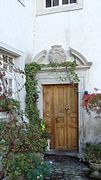Klingenberg Castle (Homburg)
Klingenberg Castle is a castle near Homburg in the Swiss canton of Thurgau . The history of Klingenberg Castle goes back to the 13th century, when a fortress was built on the castle hill behind today's castle . Nothing of this castle has survived today, the shape and size can be guessed from old photo documents.
history
middle Ages
The former castle was once the ancestral seat of the von Klingenberg family of ministers, who established a closed judicial system here in the second half of the 13th century . The lords of Klingenberg were influential servants of the Habsburgs and provided a number of important abbots, bishops, diplomats, knights and poets.
Of the noble Klingenbergers, Heinrich II in particular is known today . He was Chancellor of King Rudolf von Habsburg and became Bishop of Constance in 1293. When the Klingenberg family died out, the rule was inherited in 1360 by Hermann von Breitenlandenberg, in 1407 by Ulrich Peyer and in 1448 by Friedrich von Heidenheim, in whose line she remained for over 200 years.
Early modern age
During the Old Zurich War , the castle burned down in 1444, including the mill, Torggel , barn and another house. It was rebuilt two years later. The construction of the lower castle at the foot of the castle rock and the castle chapel, the location of which is no longer known today, probably fell during this time.
In 1651 the abbot of the Benedictine monastery Muri bought the castle and the manor, including the church patronage of Homburg. In 1694, the eastern gable wall of the upper castle fell to the ground. The reconstruction was connected with an extension of the Lower Castle - almost at the same time the construction of a separate chapel began . In 1695 the restored castle burned down to the basement floor, which also affected the unfinished chapel. In 1722 the lower castle burned down and the chapel was damaged again. As a result, today's west wing was rebuilt. In 1732 the barn next to the chapel burned down. This gave Abbot Gerold Haimb the opportunity to build a new south wing and to add the east wing to it, so that a monumental baroque three-wing complex was created. In 1772 the Lower Castle was again ravaged by fire. Today's moat was probably created during the reconstruction as an architectural ornament of the castle.
Later use
In 1812 the territory was assigned to the municipality of Homburg. With the abolition of the monastery and the secularization in 1841, the possessions came to the state of Lucerne and became private property from 1844. In 1849 the Upper Castle was demolished. After several changes of ownership, in 1901 the Santo family, who immigrated from South Tyrol , bought the property, which had meanwhile been in a desolate state, and over years of work brought life back into the old walls. On the initiative of the Pro Klingenberg Committee, various restorations were carried out between 1960 and 1980 with the cooperation of the cantonal and federal preservation authorities. Since then, Klingenberg Castle has been under federal protection.
Klingenberg Castle has been privately owned again since 2005. The owners are continuously financing a large renovation and restoration program, which means that a large part of the palace is now open to the public again.
photos
literature
- Alexander Werder, Alfons Raimann, Hans Peter Mathis: Klingenberg Castle, Homburg Church and Oberkappel Chapel ( Swiss Art Guide , No. 673). Ed. Society for Swiss Art History GSK. Bern 2000, ISBN 978-3-85782-673-3 .
- Erich Trösch: Klingenberg. In: Historical Lexicon of Switzerland .
- Klingenberg Castle. In: Alfons Raimann, Peter Erni: The art monuments of the Canton of Thurgau. Volume VI: The Steckborn district (= Art Monuments of Switzerland, Volume 98). Edited by the Society for Swiss Art History . Bern 2001, ISBN 3-906131-02-5 , pp. 97-106. ( Digitized version )
Web links
- Website of Schloss Klingenberg (archive version 2016)
Coordinates: 47 ° 37 '22.6 " N , 9 ° 0' 10.6" E ; CH1903: seven hundred and seventeen thousand five hundred eighty-seven / 275 870




